6 Common Australian House Spiders

Bites and Stings
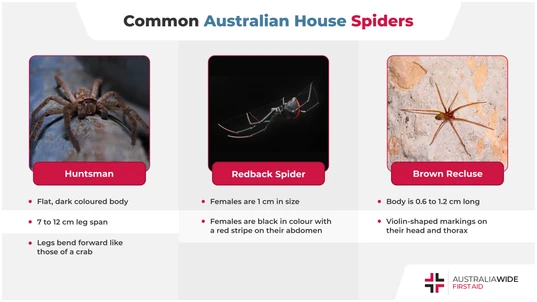
Australia is home to approximately 10,000 spider species, several of which have a predilection for indoor living. Today, we look at the spiders you are likely sharing your house with, and whether they are cause for concern.
Here in Australia, there are a handful of spider species that have a penchant for venturing into homes and setting up stumps. There are several reasons why certain spiders prefer the indoors – they are averse to the hot or cold, or their ideal prey is also inclined to indoor living. While most of these spiders are not cause for concern, it is important to be familiar with their characteristics and behaviour. That way, you can live together harmoniously without the risk of a bite, which are usually painful regardless of the toxicity of the venom.
Daddy-long-legs spiders can be found in every continent across the globe, save for Antarctica. They enjoy warm climates, and are now one of Australia's most common spider species.
Daddy-long-legs Spider
The Daddy-long-legs spider is a member of the Pholcidae family of spiders. They are so named because of their incredibly lengthy limbs, which are approximately five times longer than their bodies. The female’s body is generally 8 millimetres (mm) in length, while the male’s body tends to be 6 mm long. Daddy-long-legs spiders are typically cream to pale brown in colour, and their eight eyes are clumped together at the front of their bodies. In the outdoors, they can be found in dark, damp areas – for instance, in caves, abandoned burrows, and under rocks. In urban areas, meanwhile, they prefer quiet, undisturbed areas of the home, including corners, attics, and cellars. Daddy-long-legs spiders are a passive bunch. And though they prey on more dangerous spiders like the Redback and Funnel-web, their venom is not potent and does not constitute a threat to humans. In fact, Daddy-long-legs spiders could be considered a useful addition to the household, as they keep the number of dangerous spiders in check – make sure to give them ample space, however, as their bite can induce a short-lived burning or stinging sensation.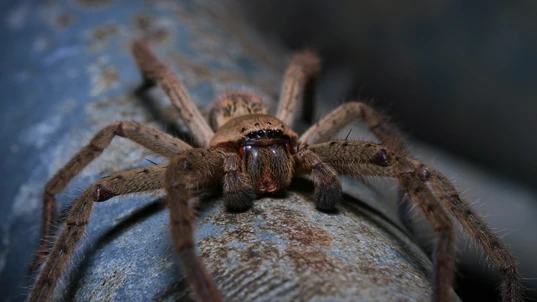
Huntsman spiders can be found in many warm climates across the world, including Africa, the Americas, and much of Australasia. In fact, 94 different Huntsman spider species are known to occur in Australia alone.
Huntsman Spider
The Huntsman spider is a member of the Heteropodidae family. They are so named because they use their excellent speed and agility to run down their prey in the dead of night. Huntsman spiders are generally dark coloured to support their nocturnal feeding habits. Likewise, they have long, hairy legs that bend forward like those of a crab and allow them to move quickly in any direction. Their body is also flat, which allows them to live under loose tree bark, as well as rocks, logs, and other litter. Their flat body also allows them to weasel into homes and cars, which they are prone to do when conditions are humid. Despite their formidable size, Huntsman spiders are not considered dangerous to humans, as they prefer to run away in the face of confrontation. Like Daddy-long-legs spiders, Huntsman spiders are great natural pesticides, as they keep cockroach numbers low. If you do decide to give your neighbourhood Huntsman spider a long-term lease, just make sure not to provoke them, as their bite can cause localised pain and swelling.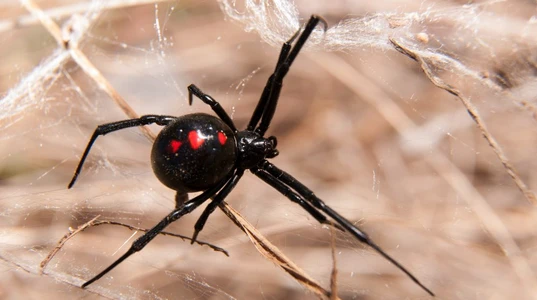
Redback spiders are considered native to Australia, and they are known to build webs close to human habitation throughout the country. Their webs typically comprise a funnel-like upper retreat area surrounded by sticky catching threads.
Redback Spider
The Redback spider is a member of the Theridiidae family. They are so named because female Redback spiders have a brilliant orange to red stripe on the top of their abdomen. While female Redback spiders tend to be black in colour, their male counterparts are usually light brown with white or yellow markings on their abdomen, as opposed to orange or red ones. Male Redback spiders also only grow to a modest 5 mm, while females are generally 1 cm in size. Both can be found in any environment where there is sufficient food, shelter, and warmth. In saying that, they have a particular fondness for setting up camp close to human habitation, including in sheds, toilets, and under rocks and junk piles. Female Redback spiders are more aggressive than their male counterparts – but, even then, most bites only occur when a person inadvertently dislodges the spider from its hiding place. Since the invention of antivenom in 1955, no deaths have occurred from a Redback spider bite, though they can cause severe symptoms that may require medical attention, including intense localised pain and swelling at the bite site, muscle spasms, nausea, sweating, and vomiting.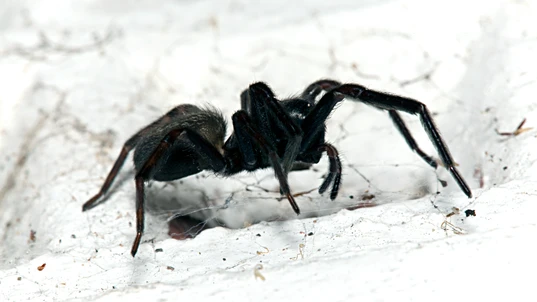
Black house spiders are native to Australia and can be found throughout the country. As humans continue to encroach on their natural habitats, Black house spiders have adapted well to urban living.
Black House Spider
The Black house spider belongs to the Desidae family of spiders. They are so named because their carapace is usually dark brown to black in colour, and they can be found in windows, doorways, and corners of the home. Black house spiders are generally small, with females growing up to 12 – 18 mm in length, and males growing up to 9 – 15 mm in length. Short grey hairs are usually visible on their carapace, while their abdomen is typically grey and covered in variegated patterns of white markings. In the outdoors, they can be found on tree trunks, as cracks in the bark provide good shelter. Black house spiders dwelling indoors, meanwhile, prefer to build their funnel-shaped webs near light sources, as these attract moths, beetles, and other ideal prey. Black house spiders are not considered a threat to humans, as they are shy, timid, and prefer to hide away in their webs from any potential predators. Like many of the spiders discussed here, Black house spiders are useful for keeping local insect populations under control. However, their bites can be excruciatingly painful and cause localised swelling, nausea and sweating. So if you want to remain on good terms with your resident Black house spider, make sure to leave them and their web alone.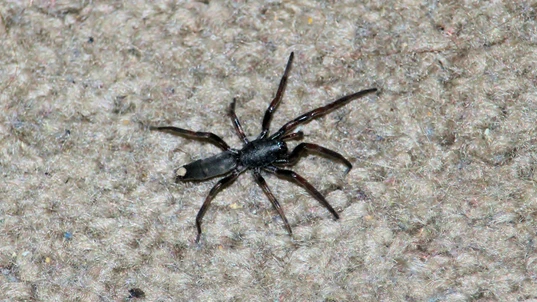
The two most common species of White tail spider are Lampona cylindrata and Lampona murina. Lampona murina can be found in eastern Australia, while Lampona cylindrata prefers the cold and can be found across southern Australia.
White Tail Spider
The White tail spider belongs to the Lamponidae family of spiders. They are so named because they have two small white spots at the rearmost tip of their abdomen. Unlike many Australian spiders, which tend to be short and stocky, the White tail spider has a cigar-shaped body that usually grows up to 18 mm in length and is grey to dark reddish in colour. They also have dark orange-brown bands on their legs, which can span up to 5 cm in length. In the outdoors, White tail spiders tend to live beneath bark, rocks, and leaf litter. They are known to venture inside and hide between folds of fabric, however, during the night or when the weather gets warmer to prey on Black house spiders. White tail spiders are not aggressive, and they generally only bite humans when they are startled – for instance, when they are hiding in a towel that is suddenly thrust against a person’s body. Though White tail spider bites have been sensationally associated with ulcerative skin lesions, they typically only cause symptoms synonymous with those of a bee sting, such as a burning sensation at the bite site, localised swelling, and some skin discolouration – to avoid this discomfort, make sure to shake your T-shirts free of any White tail spiders before putting them on!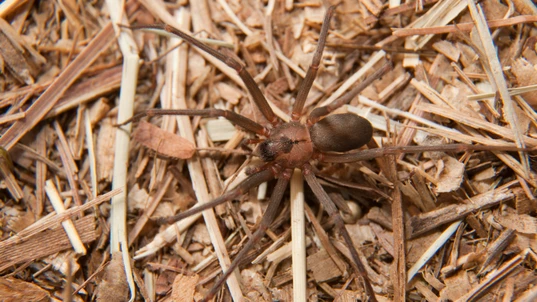
Brown recluse spiders can be found throughout the world. Though they love warm climates, Brown recluse spiders were introduced to Australia, and they are most common in central and southern parts of the United States.
Brown Recluse Spider
Brown recluse spiders belong to the Sicariidae family of spiders. They are so named because they are brown in colour and have a shy and passive nature. As well as being brown in colour, Brown recluse spiders generally have violin-shaped markings on their cephalothorax, which is why they are sometimes called the Fiddleback spider. Brown recluse spiders are also distinct in that they only have six eyes, whereas most spiders have eight. In the outdoors, Brown recluse spiders like to live under rocks, logs, and woodpiles. They are also well adapted to living indoors alongside humans and spend their days hidden away in dark, secluded areas – for instance, in seldom-used apparel, under furniture, or in the crevices of window mouldings. Like White tail spiders, Brown recluse spiders generally only bite humans when they are inadvertently trapped against human skin. If you are bitten by a Brown recluse spider, you may experience the following symptoms: localised pain and swelling, head and body aches, and discolouration at the bite site that may turn into an ulcer. To avoid this discomfort – make sure to check that your clothes and shoes are Brown recluse-free before putting them on!First Aid for Common Australian House Spider Bites
Bites from the spiders mentioned in this article can be treated with the same first aid procedure used for Redback spider bites:- Reassure the casualty and keep them under constant observation.
- Apply a cold compress to the bite site for periods of up to 20 minutes to lessen the pain.
- If the casualty is a young child (under 8 years), a pregnant woman, or if they exhibit any signs of deterioration, follow the basic life support guidelines per DRSABCD and call Triple Zero (000) for an ambulance.
- DO NOT use the Pressure Immobilisation Technique, as the venom moves slowly and this will just worsen the pain.
Spider Bites and Anaphylaxis
Some people can have a severe allergic reaction when bitten by a spider. This is called anaphylaxis, a condition that can be fatal in as little as 15 minutes. Symptoms include:- Tightness of the throat from swelling.
- Difficulty breathing.
- Tongue and facial swelling.
- Hoarse voice or difficulty speaking.
- A wheeze or persistent cough.
- Collapse or falling unconscious.
- Becoming pale or floppy (young children).
- Abdominal pain and vomiting.
- Hives, welts, and body redness.
Looking to get you First Aid knowledge up to date?
We run certified First Aid courses throughout all major Acustralian citys. Find a location near you.
Final Thoughts
Here in Australia, we do not have to worry about apex predators, such as bears, cougars, or wolves. However, our country is still teaming with potentially dangerous creatures. As we have seen here today, the average Australian home is brimming with several spider species that prefer indoor living. Luckily, most of these spiders are shy and passive in nature and will only bite humans when they are startled or provoked. Likewise, many of these spiders play a vital role in keeping local pest populations under control. To avoid encountering these spiders, make sure to shake out your shoes and clothing before putting them on. You should also never put your hands into places you can’t see. For more tips and tricks on how to manage spider bites, book a First Aid course with Australia Wide First Aid today.
Originally published at
https://www.australiawidefirstaid.com.au/resources/common-australian-house-spiders
as part of the Australia Wide First Aid Articles Library









